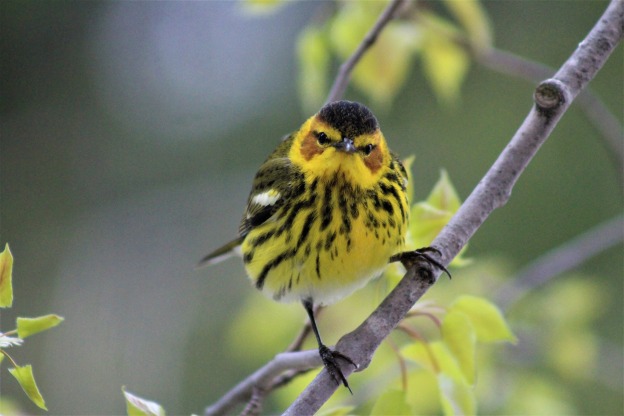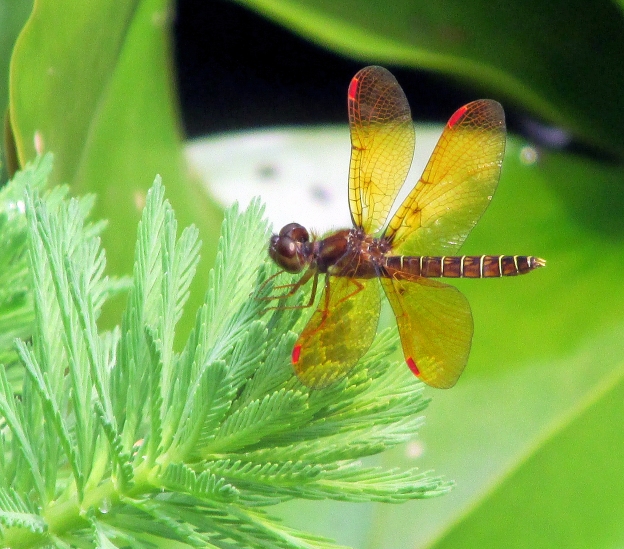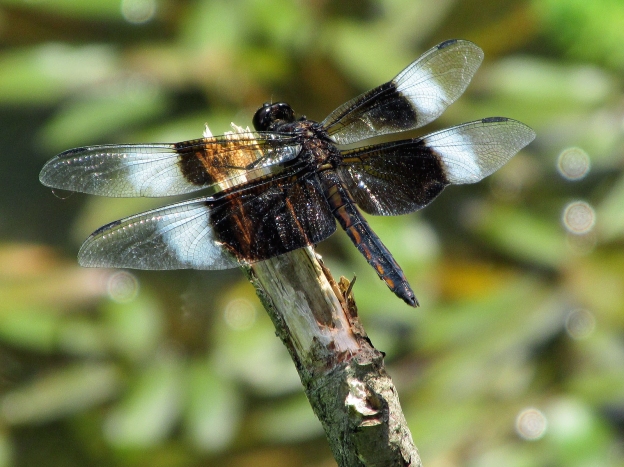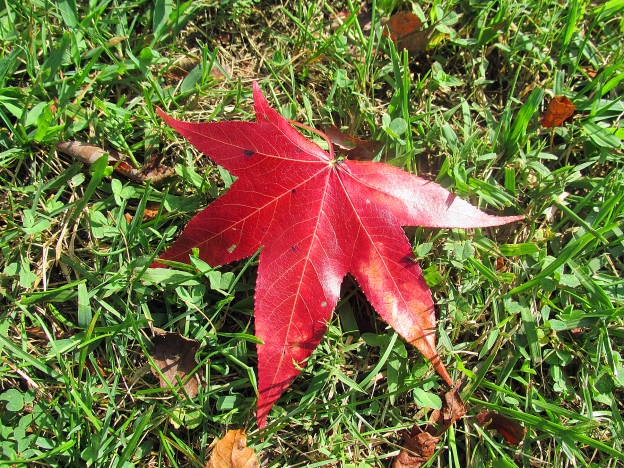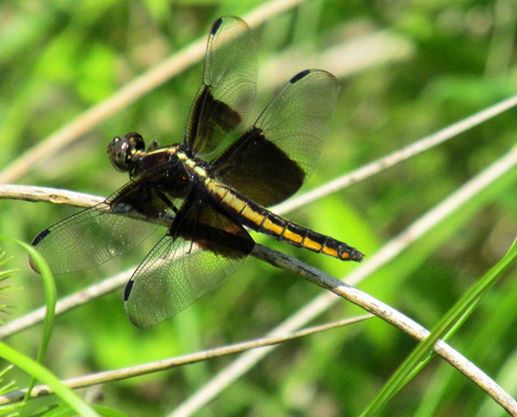
Photo by Bryan Stevens Photo by Bryan Stevens A female common skimmer, a species of dragonfly, basks in the sunshine to help boost her energy reserves for hunting. Dragonflies, with a kill rate of 90%, are one of the world’s most deadly and efficient predators.
I am taking a hiatus from the birds for one week to introduce readers to some “other things with wings.”
Specifically, I want to discuss dragonflies and damselflies, otherwise known as “odes,” or members of the insect order of Odonata. Surprisingly, beyond the fact that both have wings, the odes and birds have a lot in common.
When birds are scarce during the heat of the day, I find that other winged creatures get active and can provide some fun observations. In late summer I spend a great deal of time focused on the dragonflies and damselflies that live along the creek and at the fish pond at my home. The “odonates” are insects with long brightly colored bodies, two pairs of membranous wings and large compound eyes.

Photo by Bryan Stevens
A glimpse through the vegetation at one of the pond’s most voracious predators. Dragonflies consume many other species of insects, including some that are considered pests. Pictured is a female Blue Dasher.
Some of the more prevalent dragonflies in the region include widow skimmer, common whitetail, Eastern pondhawk, Eastern amberwing and slaty skimmer. There are less common odes that also put in appearances at my home along Simerly Creek Road. Gray petaltails and tiger spiketails, two larger dragonfly species, put in almost annual appearances.
I also often find the ebony jewelwing, a species of damselfly, fluttering along the creek. These delicate-looking insects like to find a sunny perch near flowing water. I’ve noticed the ebony jewelwings for many years because they are particularly difficult to miss. They have dark wings and a tapering body that glistens with a metallic blue-green sheen.
Damselflies, which are closely related to dragonflies, are usually smaller and less swift. A dragonfly at rest keeps its wings extended horizontally like an airplane’s wings, but damselflies fold their wings over their backs.
All odes are predators, feeding on other insects, but they are harmless to humans. Despite an enduring myth, they cannot sting. They are capable of biting, but will not do so unless they are handled in a careless manner.

Photo by Bryan Stevens
The aptly-named Autumn Meadowhawk is one of the last dragonflies to emerge each year.
If you observe dragonflies long enough, you will start to notice they share one trait with hummingbirds: they are intolerant of any intrusion into their personal space. Like feisty hummingbirds, dragonflies constantly chase rivals away from a favorite perch, restlessly patrolling the edge of a pond. They are unceasing in their chasing and harassing of rivals.
Some cultures consider a dragonfly landing on a person a sign of good fortune. My sister-in-law would disagree. She has an intense, if irrational, fear of dragonflies. Perhaps she learned too much of the misinformation handed down in various human cultures about dragonflies.
Europeans have long linked dragonflies with sinister forces. Some common names for dragonflies, such as darners, come down from older names such as “devil’s darning needle.” Swedes call dragonflies “troll spindles” and Norwegians refer to them as “eye pokers.” Some cultures in South America call dragonflies “horse killers” and others refer to them as caballito del diablo, or the “devil’s little horse.” Some residents of the Southern United States refer to dragonflies as “snake doctors,” believing these insects can stitch and repair any injuries that a serpent suffers. It’s no wonder some people fear a harmless and rather beneficial insect.
Native Americans as well as some Asian cultures have a more positive outlook on dragonflies. In Japan, dragonflies represent such concepts as strength, courage and joy. Dragonflies are often depicted in Zuni pottery, and the Navajo use the dragonfly as a symbol to represent “pure water,” which was an important resource for people living in very arid conditions. For both birds and dragonflies, water is also a crucial resource if they are to thrive.
The Hopi and Pueblo tribes also incorporate dragonflies into their art. Many Native Americans consider dragonflies a symbol of renewal. Many others see them as a symbol representing illusion and seeing through deception. I wonder if the use of the dragonfly as a renewal symbol evolved because of the life cycle of dragonflies.
Odes spend the first stage of life as aquatic larvae living below the surface of the water. Later, they emerge as adult dragonflies. During their time spent as larvae, or nymphs, they are voracious predators, tackling other aquatic organisms, including small fish. At the same time, these nymphs are important food sources for some larger fish. Nymphs may spend as long as three years living beneath the water, but adult dragonflies usually live only a few weeks or months.
Adult dragonflies continue to consume prey, which is mostly other insects. Among the odes, there are no vegetarians. “Mosquito hawk” is another common name for them because they catch and eat mosquitoes. They also consume gnats, flies and other insects. So, along with birds such as swallows and nighthawks, the dragonflies help keep in check the numbers of many nuisance insects.
Some of the larger dragonflies are also reputed to attack and eat hummingbirds. I tried to find conclusive evidence, but the jury’s still out in my opinion. However, some of the larger species of praying mantis have been documented capturing and consuming hummingbirds, so it is not too far-fetched to believe some of the larger dragonflies might be capable of preying on hummers.
Like many birds, some dragonflies migrate. Species such as Carolina saddlebags, green darners and wandering gliders are known to migrate hundreds of miles.
In recent years, dragonfly-watching has emerged as a nature pastime to rival the watching of birds and butterflies. Why watch dragonflies? Well, in many ways, they are just as fascinating as birds and other wildlife
Here’s some additional fun trivia about dragonflies:
• Odes have excellent eyesight. Their compound eyes have up to 30,000 facets, each of which is a separate light-sensing organ arranged to give nearly a 360 degree field of vision. Their vision also makes it difficult to sneak up on a dragonfly. I have learned this during my attempts to photograph them.
• Dragonflies are built for speed. Many experts credit dragonflies with the ability to fly at speeds between 19 to 38 miles per hour. They have also been documented traveling as much as 85 miles in a single day.
• Dragonflies can hover and fly backwards, a feat achieved by only hummingbirds among our winged friends with feathers.
• Dragonflies are among the world’s most efficient predators, successfully capturing prey at a whopping 90% of their attempts. In other words, nine times out of 10, dragonflies capture and eat other insects.
• Dragonflies are ancient. They appeared 100 million years before dinosaurs and 150 million years before birds.
• The largest dragonfly to ever live was Meganeura monyi, which lived during the Carboniferous period about 300 million years ago. It resembled and was related to present-day dragonflies. With a wingspan of almost 26 inches, it is one of the largest known flying insect species.





